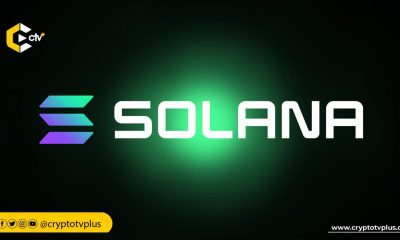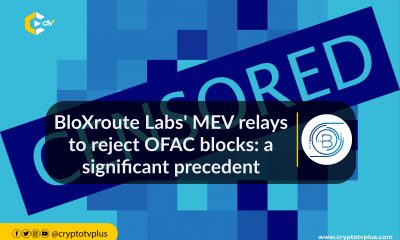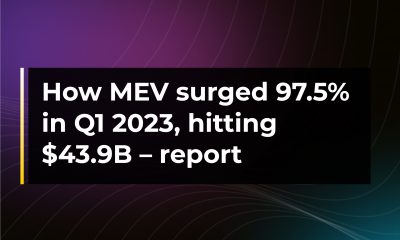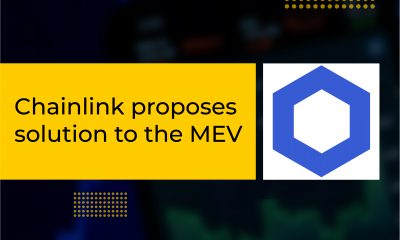FEATURED
Understanding Miner Extractable Value (MEV): Risks, & Responsible Practices in the Blockchain Space

In recent times, the world of cryptocurrencies has witnessed a surge in the popularity of meme coins. These humorous, risky, and often satirical digital tokens have captured the attention of investors and traders looking to ride the wave of the latest internet sensation.
However, as the frenzy around meme coins intensifies, so does the potential for exploiting vulnerabilities within the decentralized finance (DeFi) ecosystem. One vulnerability that has become a significant concern is Miner Extractable Value (MEV) and its impact on the crypto community.
Can you imagine the advantage of being at the forefront of the queue to engage in arbitrages, execute liquidations, and trade ahead of others? That’s kind of what MEV is all about.
Well, while MEV itself is not inherently malicious, its exploitation through various techniques, including sandwiching attacks, has raised alarms within the crypto community, especially considering the recent popularity of sniping meme coins.
The term “Sniping meme coins” describes the act of attempting to profit from the rapid price movements and liquidity fluctuations of these volatile tokens, and it has become a new avenue of interest for many individuals. However, it is crucial to recognize that with the pursuit of quick gains also comes inherent risks, including the possibility of falling victim to bots that capitalize on the MEV phenomenon.
This article aims to shed light on the concept of MEV, explain the mechanics of sandwiching attacks where attackers exploit vulnerabilities in order book structures to profit from unsuspecting traders, its impact on the broader DeFi landscape, and ultimately educate you on the potential dangers involved in sniping meme coins.
Definition of MEV
Miner Extractable Value (MEV) refers to the profit that miners or validators can extract from the execution of transactions within a blockchain network. In simple terms, it represents the additional value that miners can capture beyond their block rewards and transaction fees.
MEV exists due to the inherent transparency and public nature of blockchain systems, allowing miners to observe and potentially manipulate transaction ordering. It is a unique characteristic of blockchain networks and differentiates them from traditional financial systems.
In traditional finance, centralized intermediaries hold significant control over transaction sequencing and can prevent or exploit similar opportunities. In contrast, the decentralized nature of blockchain networks allows miners or validators to influence the order in which transactions are included in blocks, thereby creating MEV opportunities.
Origins of MEV
MEV has been present in blockchain networks since their inception. During the beginning stages of MEV, extraction bots were developed to identify lucrative prospects and engage in competition with one another for blockspace using Priority Gas Auctions (PGAs). These bots would engage in a competitive bidding process, driving up transaction fees with the aim of securing priority in transaction ordering. The outcome of this activity included periods of increased gas prices, a congested pool of pending transactions, and wasted gas, as attempted transactions still required some gas payment for operations.
However, its significance and exploitation gained prominence as DeFi applications proliferated and decentralized exchanges (DEXs) gained traction.
The increased adoption of smart contracts and automated market-making algorithms in DeFi introduced new possibilities for MEV extraction. Traders seeking to maximize profits often execute transactions based on anticipated market movements. Miners can identify these transactions before they are included in blocks, allowing them to front-run or back-run these trades for their own benefit.
Generating MEV in DeFi
In the dynamic world of cryptocurrency trading, one must learn how to navigate the concept of price deviation, commonly known as slippage. Slippage serves as a parameter that allows users to balance two crucial priorities in a rapidly moving or low liquidity market. It accounts for the fact that prices may change between the time an order is placed and when it is processed. Failing to fill an order leads to a transaction reversal, incurring gas fees but leaving the trade unexecuted. The repeated frustration and costliness of unsuccessful trades are addressed through the ingenious mechanism of slippage.
However, it is within this realm of slippage that cunning sandwich bots come into play, exploiting the intricate nuances of price deviation to their advantage. These MEV bots possess an uncanny ability to estimate the impact of a significant order while engaging in the art of frontrunning. Their ultimate aim? To optimize their profits by skillfully manipulating the executed price within the designated slippage range specified by the targeted transaction.
In the process of block production, miners or validators gather pending transactions and create a new block by adding them to the blockchain. They have the authority to determine the order in which these transactions are included in the block.
Source: Alpha Venture Dao
When a user places a transaction order, it resides in a publicly accessible area known as the mempool until it is executed on the DEX smart contracts and settled on Ethereum. Bots diligently monitor all pending transactions in the mempool with calculated precision. By intelligently assessing the potential consequences of the order’s size, the bot meticulously positions itself to fill as much of the order as possible at the maximum price allowed within the slippage threshold.
When there is potential profitability in pre-empting your order, the bot either pays a higher gas fee than you did or entices a miner to prioritize its transaction over yours in the upcoming Ethereum block.
The bot purchases the token you intended to buy ahead of you and subsequently sells it back to you at an inflated price, resulting in financial losses such as receiving fewer tokens or obtaining an unfavourable exchange rate.
To illustrate this strategy, let’s consider the case of the $LADYS token trading on a decentralized exchange (DEX). A user places a substantial buy order for LADYS, causing the price to experience an upward surge. Sensing the potential for profit, an MEV bot initiates a sandwich attack.
The bot’s first move is to quickly purchase $LADYS tokens ahead of the pending transaction at an average price between the initial and anticipated prices. This allows the bot to accumulate tokens at a lower cost, setting the stage for its profit-seeking manoeuvre.
With LADYS tokens in hand, the bot proceeds to inject liquidity into the DEX by offering the tokens for sale at an inflated price. Simultaneously, it ensures that its transaction is placed ahead of the targeted buy order. As a result, the pending order executes, purchasing the LADYS tokens from the bot at an inflated price.
The consequence is twofold: the bot secures a risk-free profit by selling tokens at an advantageous price, while the unsuspecting trader pays a higher price than anticipated for their desired tokens. This deliberate manipulation of transaction orders benefits the bot at the expense of the trader.
For example, let’s assume the initial price of LADYS tokens was 0.002351 ETH, and the anticipated price after the pending transaction was 0.002389 ETH. The MEV bot strategically purchased LADYS tokens at an average price of 0.002365 ETH before executing the sandwich attack.
Once the transaction sandwich is complete, the bot finalizes its attack by engaging in back running. It sells a portion of the LADYS tokens obtained from the targeted order to the automated market maker (AMM) pool. As the market adjusts and the price corrects itself due to the participation of other traders, the bot repurchases the tokens at a lower price, further increasing its overall profit margin.
Studies have shown that successful transaction sandwiching attacks can result in significant profits for MEV bots. In some instances, these bots have reported profit margins exceeding 20% of the total transaction value. This demonstrates the lucrative nature of this strategy when skillfully executed.
MEV Strategies and Techniques
Since the Merge (mid septemer, 2022), approximately ~200,000 ETH (~$360 million) in value has been extracted, indicating an annualized run rate of approximately ~$562 million, as reported by the Flashbots Data Dashboard. It’s important to note that this figure represents revenue, not profit, as MEV bots, also referred to as “searchers,” need to pay exorbitant transaction fees to outperform other bots in the competition.
While calculating the precise total profit is challenging, the most successful wallet address is identified as “jaredfromsubway.eth”.
Over the course of its operations, this MEV bot has showcased an astonishing performance in terms of transaction fees (gas) expenditure and profit generation. Impressively, this bot has expended a staggering total of $28,906,936.58 on transaction fees. Incredibly, despite the substantial gas expenses, the MEV bot has managed to achieve a remarkable profit of approximately $2.5 million. The bot consumes an astonishing 6.4% of all Ethereum gas over the span of a month. This dominance in gas consumption underscores the magnitude of its operations and the profound influence it wields within the Ethereum ecosystem.
Several strategies and techniques employed by miners or validators to extract MEV are:
A) Front-running: Front-running occurs when a miner or validator observes a pending transaction and, based on its content or anticipated impact on the market, submits their own transaction with higher gas fees to be included before the original transaction. It takes advantage of the time delay between the submission of a transaction and its inclusion in a block. This allows them to profit from the market movement caused by the subsequent transaction.
Front-running raises concerns regarding fairness and market transparency, as it allows miners or validators to profit at the expense of regular traders or investors. It introduces an unfair advantage and can lead to price manipulation and reduced market confidence.
B) Back-running: Back-running, also known as tailgating or shadowing, is a strategy similar to front-running but executed after a specific transaction but before its inclusion in a block. Back-running allows miners or validators to observe pending transactions and anticipate their impact on the market.
Here’s how back-running typically occurs:
– Identifying market-moving transactions: Miners or validators monitor pending transactions that are likely to trigger significant market movements. These transactions could include large trades, liquidations, or other impactful actions.
– Transaction execution timing: Miners or validators strategically submit their own transactions after the observed transaction but before it is included in a block. By timing their transactions correctly, they can take advantage of the subsequent price changes caused by the observed transaction.
– Capitalizing on market movement: Back-runners aim to profit from the price movements that occur due to the execution of the observed transaction. They can buy or sell tokens at more favourable prices and potentially profit from the subsequent price fluctuations.
C) Arbitrage opportunities: MEV can arise from exploiting price discrepancies between different markets or exchanges. Miners or validators can identify such discrepancies, execute trades across multiple platforms, and capture the price difference as profit.
It is important to note that arbitrage opportunities in MEV are not limited to simple token price differences. They can also involve other types of imbalances, such as discrepancies in interest rates, lending rates, or liquidity provision rewards. Miners or validators exploit these imbalances to maximize their profits.
D) Liquidations and stop-loss orders: MEV can impact liquidations and stop-loss orders in DeFi. Miners or validators can manipulate the order of transactions to trigger liquidations or stop-loss orders and profit from the resulting price movements.
The Impact of MEV on the Market
MEV has significant implications for the efficiency and fairness of the market within blockchain networks. The extraction of MEV can distort the natural price discovery mechanism and disadvantage regular traders and investors. It introduces market inefficiencies and can lead to increased transaction costs and reduced trust in the integrity of the DeFi ecosystem.
MEV can result in several consequences:
- Unfair advantage: Miners or validators with access to MEV extraction techniques gain an unfair advantage over regular traders and investors. This advantage erodes the principles of equal opportunity and fair competition within the market.
- Reduced market transparency: MEV extraction can undermine the transparency of market operations. When transactions are reordered or manipulated, it becomes challenging for participants to trust the integrity of the market and make informed decisions.
- Increased volatility: MEV strategies, such as front-running and back-running, can contribute to increased market volatility. The rapid execution of trades based on privileged information can lead to sudden price movements, negatively impacting the stability of the market.
- Liquidity imbalances: MEV can create liquidity imbalances within decentralized exchanges. By exploiting the order of transactions, miners or validators can exacerbate liquidity gaps and impact the overall functioning of trading pairs.
- Negative impact on user confidence: If left unaddressed, MEV extraction can erode user confidence in the DeFi ecosystem. Traders and investors may become hesitant to participate in decentralized exchanges if they perceive that the market is heavily influenced by unfair practices.
Safeguarding your transactions against MEV exploitation
To protect transactions from the manipulative tactics of MEV bots, leveraging market makers and the Request for Quotation (RFQ) process can serve as a robust defence mechanism.
RFQ offers a direct and efficient means for liquidity takers to trade with market makers, granting them access to optimal pricing without relying on on-chain order books or liquidity pools. This approach brings forth several advantages over traditional order book or automated market maker (AMM) systems within the realm of decentralized finance (DeFi):
1. Best pricing: By leveraging RFQ and soliciting quotes from multiple liquidity providers off-chain, users gain the ability to compare prices and secure the most competitive rates for their trades. This ensures that they obtain the best pricing available in the market.
2. Off-chain negotiation: RFQ introduces a private and gas-efficient negotiation process where parties can reach mutually agreed-upon deals through secure communication channels on the Internet. The transaction only proceeds to the on-chain stage once it has been confirmed, minimizing unnecessary on-chain congestion and associated costs.
3. Protection against front-running and sandwich attacks: With RFQ-based transactions, the inclusion of the liquidity taker’s wallet address within the on-chain transaction renders it immune to front-running or sandwich attacks by any bots. This ensures that the transaction proceeds securely without the risk of exploitation.
4. Zero slippage: RFQ-based trades are executed at pre-agreed prices, effectively eliminating slippage. This feature brings significant cost savings compared to AMMs, where slippage can erode the value of trades. With zero slippage, users can precisely execute their trades without unexpected price variations.
5. Composable liquidity: RFQ systems possess the versatility to access liquidity from diverse sources, including decentralized exchanges, centralized exchanges, aggregators, and market makers. This flexibility allows RFQ to tap into a wide pool of liquidity, ensuring the best possible prices and maximizing available liquidity for any given trade.
When it comes to conducting seamless coin swaps, bypassing direct transactions on platforms like Uniswap or SushiSwap in favour of RFQ-supporting aggregators might just unlock a range of benefits and ensure you receive the most favourable deals available in the market.
To guarantee that you obtain the best possible outcomes, consider manually comparing quotes from esteemed aggregators such as 1inch, Cowswap, Hashflow, and Matcha. These platforms enable you to assess multiple quotes side by side, empowering you with the ability to make informed decisions and secure optimal pricing.
By opting for aggregators, you gain access to the best prices in the market. Moreover, some aggregators go the extra mile by offering gas fee coverage or even providing rebates to traders (notably, Hashflow rewards traders in its native token, HFT). This added value enhances your overall trading experience, reducing costs and maximizing potential gains.
When considering the available options, it’s worth noting that 1inch boasts the most extensive range of liquidity sources, totalling 102. With a multitude of sources to tap into, 1-inch ensures that you receive competitive quotes for various assets. However, it’s important to be aware that some meme coin quotes may not be supported by aggregators like Matcha and Hashflow at present, while Cowswap presents a route with approximately 50% slippage.
MEV and Network Security
The relationship between MEV and network security is a complex one. Miners play a vital role in securing blockchain networks by validating transactions and adding them to the blockchain. However, MEV extraction can create conflicts of interest and compromise the integrity of the network.
Miners have the incentive to prioritize their own transactions or engage in MEV strategies to maximize their profits. This can introduce biases in the transaction sequencing process, potentially leading to the manipulation of block content. While miners are expected to act in the best interest of the network, MEV can incentivize them to deviate from this principle.
Addressing MEV requires striking a balance between incentivizing miners to contribute to network security while minimizing the potential for manipulation. Various proposals and protocols are being developed to mitigate MEV risks and establish a more equitable playing field for participants.
Risks and Ethical Considerations
While MEV strategies offer profit potential for miners or validators, they come with inherent risks and ethical considerations that should be acknowledged. Some of the critical risks and ethical concerns associated with MEV strategies include:
- Manipulation and unfair advantage: MEV strategies, such as front-running and back-running, can manipulate transaction ordering to gain an unfair advantage over other market participants. This undermines the principles of fair competition and market integrity.
- Market volatility and instability: MEV strategies can contribute to increased market volatility and instability. Rapid execution of transactions based on privileged information or market imbalances can lead to sudden price movements and market disruptions.
- Investor confidence and trust: The prevalence of MEV strategies can erode investor confidence and trust in the decentralized ecosystem. Traders and investors may be hesitant to participate in markets where MEV extraction is prevalent, leading to reduced liquidity and market efficiency.
- Regulatory scrutiny: MEV strategies have caught the attention of regulators, who are increasingly monitoring and scrutinizing their impact on market fairness and investor protection. Regulatory interventions may be introduced to address the risks associated with MEV extraction.
It is important for market participants, developers, and regulators to actively work together to mitigate the risks associated with MEV and establish a more equitable and transparent market environment.
Mitigating MEV Risks and Future Considerations
The crypto community recognizes the need to mitigate MEV risks and promote a fair and transparent market environment. Several techniques and protocols have been proposed or implemented to address MEV extraction. Here are some prominent approaches:
- MEV Auctions: One approach involves introducing MEV auctions, where miners or validators compete to include transactions with higher MEV potential. This mechanism enables market participants to capture the value of their transactions while reducing the incentive for miners to extract MEV through front-running or back-running.
- Transaction Ordering Protocols: Researchers are exploring the development of transaction ordering protocols that aim to remove or reduce the influence of miners or validators in determining transaction orders. These protocols leverage cryptographic techniques, such as verifiable delay functions (VDFs), to create a more decentralized and fair transaction sequencing process.
- Privacy Solutions: Enhancing transaction privacy can be another avenue for mitigating MEV risks. By making transaction details less observable, miners or validators have fewer opportunities to exploit transaction information for MEV extraction. Techniques like zero-knowledge proofs, off-chain computation, and layer-2 scaling solutions are being explored to enhance privacy.
- Flashbots: Flashbots is an initiative that aims to provide a safer and more transparent environment for MEV-related activities. It enables users to directly submit their transactions to miners without exposing them to the public mempool. This reduces the likelihood of MEV extraction and allows for more predictable transaction execution.
- Smart Contract Design: MEV risks can be mitigated through thoughtful smart contract design. Implementing mechanisms like time-based delays, fair ordering, or randomization can help reduce the exploitable opportunities for MEV strategies. Smart contract developers are actively exploring ways to minimize MEV vulnerabilities in their code.
MEV mitigation is an ongoing and evolving research field. As the crypto community seeks to address MEV risks, several areas of research and future considerations are being explored:
- Standardization and Best Practices: Establishing industry-wide standards and best practices can help promote a more secure and fair market environment. Collaborative efforts among researchers, developers, and industry stakeholders can lead to the development of guidelines and recommendations for mitigating MEV risks.
- Network Upgrades and Protocol Changes: Network upgrades and protocol changes play a crucial role in addressing MEV risks. Blockchain networks can introduce changes to transaction ordering mechanisms, gas pricing, or consensus algorithms to create a more level playing field and reduce the impact of MEV extraction.
- Enhanced Transparency and Monitoring: Tools and analytics platforms that provide real-time monitoring of MEV activities can help detect and mitigate potential risks. By increasing transparency and making MEV activities more visible, market participants can make informed decisions and identify potential vulnerabilities.
- Community Education and Awareness: Educating the community about MEV risks, strategies, and their implications is vital. Increased awareness can lead to better-informed decisions and foster a culture of responsible trading and participation in the market.
- Collaboration and Governance: MEV mitigation requires collaboration among stakeholders, including developers, researchers, regulators, and market participants. Building governance mechanisms that facilitate open dialogue, decision-making, and coordination can help address MEV risks effectively.
Promoting Responsible Practices
In addition to educating market participants about MEV risks, promoting responsible practices is essential for a safer and fairer market environment. Here are some considerations for promoting responsible engagement:
- Due diligence: Market participants should conduct due diligence before engaging in any transactions or investments. This includes researching the projects, platforms, and protocols they interact with to understand potential MEV risks associated with them.
- Risk management strategies: Implementing risk management strategies can help mitigate the impact of MEV risks. This may include diversifying portfolios, setting appropriate stop-loss orders, and carefully considering the timing and size of trades.
- Ethical considerations: Market participants should consider the ethical implications of their actions. Engaging in MEV extraction at the expense of other market participants can contribute to an unfair and distorted market. Responsible practices prioritize fairness, transparency, and the overall health of the market ecosystem.
- Staying informed: As the landscape of MEV continues to evolve, staying informed about new strategies, research findings, and regulatory developments is crucial. Regularly accessing educational resources, participating in relevant communities, and keeping up with industry news can help market participants stay informed and make better-informed decisions.
Collaborative Research and Innovation
To effectively tackle MEV risks, collaborative research and innovation are crucial. The collective efforts of researchers, developers, industry stakeholders, and regulators can lead to the development of innovative solutions. Key considerations for future collaboration and innovation include:
– Research partnerships: Collaborations between academia, industry, and research organizations can foster cutting-edge research on MEV risks, detection mechanisms, and prevention strategies. These partnerships enable the exchange of knowledge, resources, and expertise to address the evolving challenges posed by MEV.
– Hackathons and challenges: Organizing hackathons and challenges focused on MEV can incentivize developers to create innovative solutions. These events provide a platform for participants to showcase their skills and contribute to the development of MEV-resistant protocols and tools.
– Regulatory frameworks: Regulators can continue to engage with the blockchain community, monitor market developments, and adapt regulatory frameworks to address MEV risks. Collaborative efforts between regulators, industry experts, and market participants can foster the establishment of robust regulatory frameworks that balance innovation and investor protection.
Conclusion
As MEV continues to evolve, it is crucial for individuals, organizations, and regulators to remain vigilant, adapt to new strategies, and contribute to the development of innovative solutions. By collectively working towards these goals, we can build a more resilient, secure, and equitable blockchain ecosystem that benefits all participants.
Read also; Understanding the Ethereum Virtual Machine (EVM)

























805 Comments